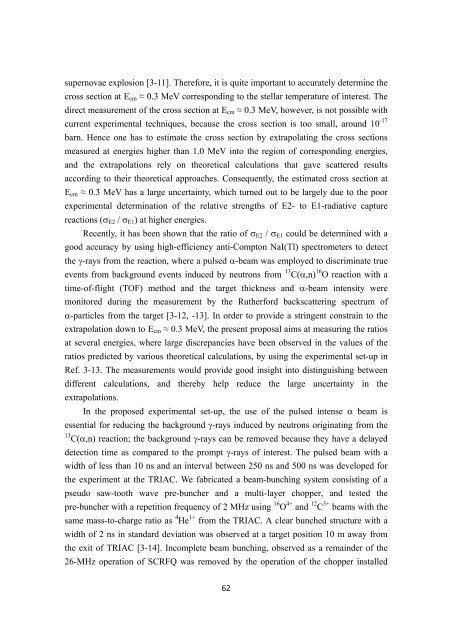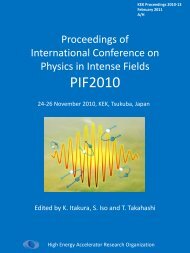TRIAC Progress Report - KEK
TRIAC Progress Report - KEK
TRIAC Progress Report - KEK
Create successful ePaper yourself
Turn your PDF publications into a flip-book with our unique Google optimized e-Paper software.
supernovae explosion [3-11]. Therefore, it is quite important to accurately determine the<br />
cross section at Ecm ≈ 0.3 MeV corresponding to the stellar temperature of interest. The<br />
direct measurement of the cross section at Ecm ≈ 0.3 MeV, however, is not possible with<br />
current experimental techniques, because the cross section is too small, around 10 -17<br />
barn. Hence one has to estimate the cross section by extrapolating the cross sections<br />
measured at energies higher than 1.0 MeV into the region of corresponding energies,<br />
and the extrapolations rely on theoretical calculations that gave scattered results<br />
according to their theoretical approaches. Consequently, the estimated cross section at<br />
Ecm ≈ 0.3 MeV has a large uncertainty, which turned out to be largely due to the poor<br />
experimental determination of the relative strengths of E2- to E1-radiative capture<br />
reactions (σE2 / σE1) at higher energies.<br />
Recently, it has been shown that the ratio of σE2 / σE1 could be determined with a<br />
good accuracy by using high-efficiency anti-Compton NaI(Tl) spectrometers to detect<br />
the γ-rays from the reaction, where a pulsed α-beam was employed to discriminate true<br />
events from background events induced by neutrons from 13 C(α,n) 16 O reaction with a<br />
time-of-flight (TOF) method and the target thickness and α-beam intensity were<br />
monitored during the measurement by the Rutherford backscattering spectrum of<br />
α-particles from the target [3-12, -13]. In order to provide a stringent constrain to the<br />
extrapolation down to Ecm ≈ 0.3 MeV, the present proposal aims at measuring the ratios<br />
at several energies, where large discrepancies have been observed in the values of the<br />
ratios predicted by various theoretical calculations, by using the experimental set-up in<br />
Ref. 3-13. The measurements would provide good insight into distinguishing between<br />
different calculations, and thereby help reduce the large uncertainty in the<br />
extrapolations.<br />
In the proposed experimental set-up, the use of the pulsed intense α beam is<br />
essential for reducing the background γ-rays induced by neutrons originating from the<br />
13<br />
C(α,n) reaction; the background γ-rays can be removed because they have a delayed<br />
detection time as compared to the prompt γ-rays of interest. The pulsed beam with a<br />
width of less than 10 ns and an interval between 250 ns and 500 ns was developed for<br />
the experiment at the <strong>TRIAC</strong>. We fabricated a beam-bunching system consisting of a<br />
pseudo saw-tooth wave pre-buncher and a multi-layer chopper, and tested the<br />
pre-buncher with a repetition frequency of 2 MHz using 16 O 4+ and 12 C 3+ beams with the<br />
same mass-to-charge ratio as 4 He 1+ from the <strong>TRIAC</strong>. A clear bunched structure with a<br />
width of 2 ns in standard deviation was observed at a target position 10 m away from<br />
the exit of <strong>TRIAC</strong> [3-14]. Incomplete beam bunching, observed as a remainder of the<br />
26-MHz operation of SCRFQ was removed by the operation of the chopper installed<br />
62













